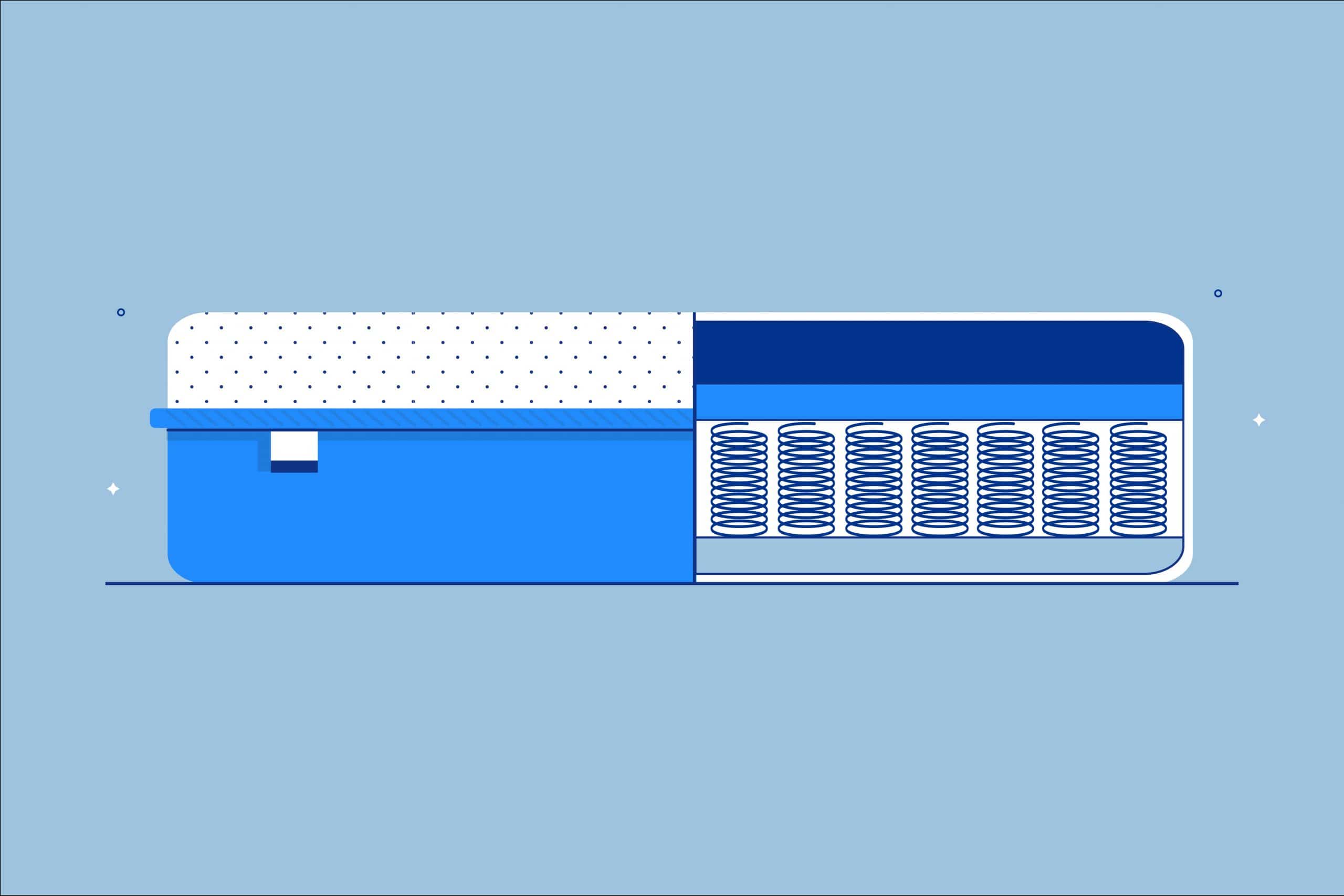Key Takeaways
- Choosing the Right Mattress: The choice between memory foam mattresses and waterbeds depends on individual comfort preferences, support needs, and other factors. It’s essential to conduct a thorough comparison and consider reviews and ratings when making your decision.
- Why Pick Memory Foam Mattresses: Memory foam mattresses are known for their excellent support and pressure relief, as they contour to the body’s shape. They are durable and hypoallergenic but may retain heat and have a sinking feeling for some sleepers.
- Why Pick Waterbeds: Waterbeds provide unique support through water-filled bladders, offering relief for back pain and pressure points. They can be beneficial for individuals with certain health conditions but may be challenging to move and require regular maintenance.
When it comes to comparing memory foam mattresses and waterbeds, it’s important to remember that the ideal mattress choice will vary based on your personal comfort preferences and the specific brands and models available.
As you explore different mattress types, it’s crucial to conduct a thorough comparison and consider factors such as reviews and ratings to make an informed decision about which mattress type is best for you.
Best Amerisleep Memory Foam Mattresses
Quick Guide: A 30-Second Summary
| Best Memory Foam Mattress Overall | Amerisleep AS3 |
| Best Firm Memory Foam Mattress | Amerisleep AS2 |
| Best Soft Memory Foam Mattress | Amerisleep AS5 |
What Is a Memory Foam Mattress?
 Memory foam mattresses feature a unique type of polyurethane foam that has remarkable contouring abilities, molding to the shape of the sleeper and then returning to its original form.
Memory foam mattresses feature a unique type of polyurethane foam that has remarkable contouring abilities, molding to the shape of the sleeper and then returning to its original form.
This special foam, known as viscoelastic foam, can efficiently distribute pressure over the whole surface. Memory foam excels at relieving pressure points. Unlike traditional springs or coils, the cells in visco foam disperse air to accommodate the sleeper instead of resisting their weight.
Advantages of a Memory Foam Mattress
Memory foam mattresses provide excellent support and comfort by contouring the body’s shape, relieving pressure points, and promoting proper spinal alignment for a more restful sleep. They also have motion isolation properties, reducing motion transfer for couples or light sleepers. They are durable and maintain their shape over time.
They are also hypoallergenic mattresses, resisting allergens and benefiting those with allergies or asthma. In addition, memory foam beds are mold-resistant mattresses due to their dense and closed-cell structure, which inhibits the growth of mold and mildew.
Disadvantages of a Memory Foam Mattress
While memory foam mattresses have many advantages, they also come with a few potential disadvantages to consider. One common concern is the heat retention properties of memory foam.
Due to its dense structure, memory foam tends to trap body heat, which can lead to a warmer sleep experience, especially for individuals who naturally sleep hot. However, this can be a bit of a memory foam mattress myth when it comes to modern options, which often have extra cooling features from plant-based or gel-infused memory foam.
Some people also find that memory foam mattresses have a sinking or “stuck” feeling, which can make it challenging to change positions during sleep. However, a well-made memory foam mattress should still be responsive to movement and lightly buoyant, snapping back into shape quickly as you stir.
What Is a Waterbed?
 A waterbed is a unique type of mattress that contains a water-filled capsule. It consists of a large bladder filled with water, enclosed in a fabric cover, and supported by durable vinyl material to prevent leaks. The water inside serves as the primary support system, allowing for customization by adjusting the water level to achieve the desired firmness or softness.
A waterbed is a unique type of mattress that contains a water-filled capsule. It consists of a large bladder filled with water, enclosed in a fabric cover, and supported by durable vinyl material to prevent leaks. The water inside serves as the primary support system, allowing for customization by adjusting the water level to achieve the desired firmness or softness.
Waterbeds come in different styles, including free-flow, waveless, and hybrid models that combine water with other materials. Some even have heating elements for temperature control. Additionally, having a waterbed means you can say goodbye to dust mites. While waterbeds were popular in the past, they have become less common in mainstream mattress options today.
Advantages of a Waterbed
Waterbeds are known for their ability to alleviate back pain and provide relief to sleepers. By distributing body weight evenly, they reduce pressure on the back and allow the spine to relax while supporting the joints.
This makes waterbeds effective for treating lumbar issues and beneficial mattresses for individuals with arthritis, as the lack of pressure helps alleviate pain and stiffness. Waterbeds can also be used for heat therapy by using a waterbed heater or warm water filling.
They are particularly helpful for insomnia sufferers due to the even weight distribution, promoting faster sleep onset. Additionally, waterbeds have been credited with providing relief for various health conditions such as allergies, ulcers, bed sores, cystic fibrosis, cerebral palsy, multiple sclerosis, and sleep apnea in newborns.
Disadvantages of a Waterbed
Waterbeds can present a few challenges and drawbacks that owners need to be aware of. One issue is the difficulty of moving and assembling these beds, which can be time-consuming and require extra effort. Sleeping on a waterbed can also make it harder to turn around during the night, as the water’s fluidity creates resistance.
Another inconvenience is the potential for the water capsules or bladders to develop a temporary smell, which can be bothersome for waterbed owners. Despite these drawbacks, it’s important to consider all factors and weigh them against the benefits before deciding if a waterbed is the right choice for your sleep needs.
Choosing the Right Bed for You
Choosing the right bed for you is essential for a restful and comfortable sleep experience. Here are some key factors to consider.
Support
Memory foam mattresses excel in providing exceptional support by contouring to the body’s shape, effectively giving pressure point relief, and promoting proper spinal alignment.
On the other hand, waterbeds offer a unique support system through the water-filled bladder, which distributes body weight evenly, reducing pressure on the back and supporting the joints.
Pressure Relief
Memory foam mattresses shine in their ability to relieve pressure by molding to the sleeper’s body shape and evenly spreading their weight, easing pressure on sensitive areas. Likewise, waterbeds serve as mattresses for pressure point relief by enabling the body to float on the water-filled bladder. This feature establishes pressure relief and creates a comforting and supportive sleep surface.
Both memory foam and waterbed mattresses can potentially help prevent bed sores, also known as pressure ulcers. Such mattresses for bed sores are good for anyone who may be on long-term bed rest, such as seniors or people recovering from surgery.
Durability
Memory foam mattresses are designed to maintain their shape and support over time. They are constructed with high-quality materials that can withstand regular use without sagging or losing their original form. The most durable mattresses with memory foam layers can last well over 10 years.
On the other hand, waterbeds also offer good durability with their sturdy construction and resistant vinyl bladder, ensuring that they can provide long-lasting support and comfort for sleepers. However, regardless of which type you choose, it’s important to have a proper bed support ready to ensure a mattress that won’t sag.
Motion Isolation
Memory foam mattresses excel at motion isolation, meaning that movements on one side of the bed are less likely to be felt on the other side. When it comes to couples comfortably sharing a bed, mattresses for motion isolation are a necessity.
In contrast, waterbeds may have less effective motion isolation due to the movement of water inside the mattress, which can transfer motion more easily.
Other Types of Mattresses
When you explore the market for mattresses, there are several other types worth considering. To make the right choice when it comes to mattress type, it’s crucial to assess your specific needs, preferences, and budget.
Latex
 Latex mattresses provide great support, pressure relief, and breathability, thanks to their natural and responsive features. You can also choose if you want your bed softer or firmer.
Latex mattresses provide great support, pressure relief, and breathability, thanks to their natural and responsive features. You can also choose if you want your bed softer or firmer.
They are made from the sap of rubber trees, making them an eco-friendly mattress option compared to synthetic materials found in air or traditional memory foam mattresses. Natural latex mattresses are long-lasting, hypoallergenic, and resistant to dust mites and mold.
See also:
Hybrid Mattresses
 Hybrid mattresses mix and match foam tops, like memory foam or latex, with pocketed coils, bringing together the advantages of both. They give you a mix of contouring, responsiveness, and support for a well-rounded sleeping experience.
Hybrid mattresses mix and match foam tops, like memory foam or latex, with pocketed coils, bringing together the advantages of both. They give you a mix of contouring, responsiveness, and support for a well-rounded sleeping experience.
With foam layers relieving pressure and isolating motion, combined with supportive and bouncy coils, hybrid mattresses aim to offer the best of both worlds. They are also an improvement on old-school innerspring mattresses, as hybrids contain individually wrapped coils that deter motion transfer.
See also:
Innerspring Mattresses
 Traditional innerspring mattresses, known for their coil-based design, consist of a sturdy network of steel coils that give support and a lively feel. An innerspring mattress comes in various firmness levels and these traditional mattresses are often more budget-friendly compared to other types.
Traditional innerspring mattresses, known for their coil-based design, consist of a sturdy network of steel coils that give support and a lively feel. An innerspring mattress comes in various firmness levels and these traditional mattresses are often more budget-friendly compared to other types.
However, some sleepers find them uncomfortable and unable to fully relieve critical pressure points. Even innerspring mattresses with pillow tops may not match the comfort of a foam mattress.
See also:
Air Mattresses
 Air mattresses are popular for their versatility and portability. They can be easily inflated and deflated using an electric pump or manual air valve, allowing for a quick and convenient setup.
Air mattresses are popular for their versatility and portability. They can be easily inflated and deflated using an electric pump or manual air valve, allowing for a quick and convenient setup.
An air mattress is also commonly used for camping trips, as they provide a comfortable sleeping surface that can be adjusted to individual preferences by adding or releasing air. This personalization can help individuals sleep well while camping.
See also:
FAQs
Is memory foam good for pressure relief?
Yes, memory foam is known for its excellent pressure-relieving capabilities. As a mattress for pressure points, it contours to the body’s shape, evenly distributing weight and reducing pressure on sensitive areas. A memory foam mattress is one of the most popular types of bed for living with chronic pain and other ailments.
What mattress is comparable to a water bed?
A memory foam mattress is similar to a water bed when it comes to its special support and contouring abilities. It shapes itself to match the body’s curves, relieving pressure and giving a personalized sleeping surface, although it feels different from a water bed.
Hybrid mattresses are also similar to waterbeds, as they can offer floating sensations that feel like you’re drifting in the water. Either of these mattress types can be cloud mattresses, designed to feel like a personal cloud carrying you off to sleep, which is quite comparable to the no-pressure feel of a waterbed.
Are water beds or memory foam mattresses more comfortable?
The comfort of a mattress is subjective and can vary depending on individual preferences. Some people may find a waterbed mattress more comfortable due to the unique floating sensation, while others may prefer the contouring and pressure-relieving properties of memory foam mattresses.
And then there are sleepers who may find that a natural latex mattress or a traditional innerspring bed is their most comfortable mattress. What works for one sleeper is subjective, and that’s why it’s important to do your research and consider what best meets your needs.
Does a water bed’s water get moldy?
No, a water bed’s water does not typically get moldy. Water beds are designed with special liners and treatments to prevent the growth of mold and mildew. The vinyl or rubber mattress of a water bed is made to be resistant to moisture and is often treated with anti-microbial agents.
As long as the water bed is properly maintained and cared for, including regular cleaning and water treatment, the water should remain free from mattress mold and other contaminants.
What are the disadvantages of a water mattress?
One disadvantage of water mattresses is the risk of leaking or popping, which can lead to water damage in the bedroom and the need for repairs or replacement. Another drawback is that water mattresses can be difficult to move or reposition due to their weight and the need for proper assembly. This makes them less than convenient for individuals who frequently rearrange their sleeping arrangements.
Water beds also require regular maintenance, compared to conventional mattress cleaning that’s infrequent and often only necessary if you don’t use a mattress protector. Meanwhile, you need to ensure the water inside a waterbed is properly treated with conditioners and additives to prevent bacterial growth, algae formation, and odors. Additionally, the water level needs to be monitored and adjusted periodically.
Conclusion
When it comes to choosing between memory foam mattresses vs. waterbeds, the decision ultimately relies on individual preferences, comfort needs, and budget, given the wide array of options available in the market today. It is crucial to thoroughly assess the advantages and disadvantages of each choice and carefully evaluate personal preferences in order to make a well-informed decision that aligns with one’s unique sleep requirements.
About the author
Geoff McKinnen is a writer focusing mainly on the healthcare industry and has written articles on everything from foods to help you lose weight to the connection between Alzheimer’s and sleep. Geoff’s passionate about helping readers improve their well-being to lead happier lives. Outside of work, Geoff enjoys cycling and hiking and believes that by leading a healthy lifestyle, he can help others do the same.
View all posts





